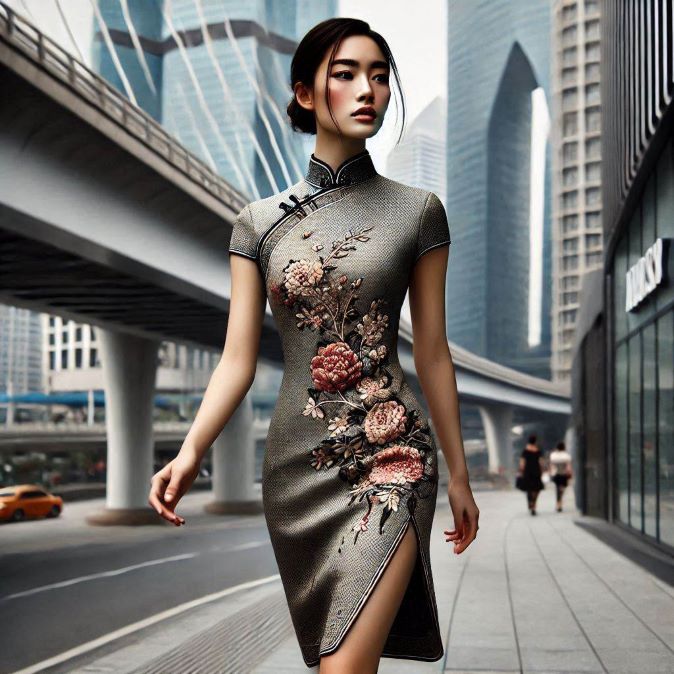Traditional Chinese dresses, particularly the qipao (cheongsam) and hanfu, are making a remarkable comeback on the global fashion scene. These garments, once primarily worn for cultural and ceremonial purposes, are now being embraced by the fashion world in China and abroad. The fusion of timeless tradition with modern design has sparked a renewed interest in these garments, making them popular for high-end fashion shows and street style.

Chinese dresses, such as the qipao, have been symbols of elegance and grace for centuries. Originating from the Qing Dynasty, the qipao is characterized by its close-fitting silhouette, high collar, and intricate patterns. Similarly, the hanfu, the traditional clothing worn by Han Chinese people, has seen a resurgence due to a growing interest in Chinese cultural heritage. These dresses, once relegated to cultural celebrations or historical reenactments, are now being reinterpreted by contemporary designers and embraced by young fashion enthusiasts. Robes Chinoises’ website (https://robeschinoises.fr) offers a collection of modernized traditional Chinese dresses, capturing the essence of these garments while giving them a fresh twist.
A Modern Twist on Tradition
Fashion trends are often cyclical, and the rise of traditional Chinese dresses is a perfect example of this. Designers are taking cues from classic Chinese aesthetics, blending them with modern styles to create a nostalgic and fresh look. The result is a marriage of heritage and innovation, where traditional elements such as silk fabric, floral embroidery, and Mandarin collars are combined with contemporary cuts, colours, and fabrics.
The qipao, for example, has evolved significantly since its inception. Once a garment worn solely by women in the elite classes, it is now a symbol of sophistication and is frequently worn at events ranging from weddings to gala dinners. Modern versions of the qipao feature updated designs, such as asymmetrical hems, shorter sleeves, and bold prints, making it suitable for various occasions. The hanfu, on the other hand, is experiencing a revival in everyday wear. While it was once reserved for special ceremonies, young people in China are now seen sporting hanfu in public spaces, combining traditional styles with modern accessories for a stylish, unique look.
Global Influence and Adaptation
The revival of Chinese dresses is not limited to China. Western designers and fashion houses have also drawn inspiration from Chinese garments, incorporating elements of the qipao and hanfu into their collections. High fashion runways have showcased Chinese-inspired dresses, with designers paying homage to Chinese culture while adapting the designs for a global audience. This cross-cultural exchange has allowed the traditional Chinese dress to gain international recognition, breaking barriers and becoming a symbol of cultural appreciation.
In addition to haute couture, Chinese dresses are making their way into everyday fashion. Global fashion influencers and celebrities are often seen wearing modernized versions of the qipao or hanfu, further fueling the trend. On social media platforms like Instagram and TikTok, the hashtag #ChineseFashion has garnered millions of views, showcasing how these dresses are being reimagined and worn by people worldwide. This level of visibility has helped normalize the wearing of Chinese dresses in everyday settings, making them accessible and appealing to a wider audience.
Cultural Appreciation or Appropriation?
While the resurgence of Chinese dresses in modern fashion is generally seen as a positive development, it has sparked conversations about cultural appropriation. Some critics argue that wearing traditional Chinese garments without understanding their cultural significance can lead to the misrepresentation of Chinese heritage. However, many fashion designers and consumers are trying to approach these garments respectfully, often learning about their history and meaning before incorporating them into their wardrobes.
The key to embracing Chinese dresses in modern fashion lies in understanding their cultural importance. For many, these garments are not just clothes—they symbolize Chinese history, art, and identity. When worn with respect and knowledge, traditional Chinese dresses can serve as a bridge between cultures, fostering appreciation for the rich history they represent.
READ ALSO: Fashion: A Strong Form of Statement
The Future of Traditional Chinese Dresses
Looking ahead, it seems that the revival of Chinese dresses in fashion is not just a passing trend. As fashion embraces diversity and cultural expression, traditional Chinese dresses will likely remain influential in the global fashion landscape. Whether through the luxurious silk of a qipao or the flowing elegance of a hanfu, these garments are reclaiming their place in modern wardrobes.
Young Chinese designers are also playing a crucial role in this revival. Many incorporate traditional elements into their collections, ensuring that Chinese fashion continues evolving while honouring its roots. With the support of local and international fashion communities, the future of Chinese dresses looks bright, with endless possibilities for reinvention and innovation.
The resurgence of Chinese dresses represents more than just a revival of fashion; it is a celebration of culture, history, and the global exchange of ideas. As the world becomes more interconnected, the traditional Chinese dress is set to remain a timeless symbol of elegance and cultural pride, appreciated by people across the globe.


